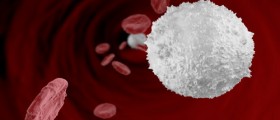
Introduction on White Blood Cells
About 1% of all blood cells are white blood cells. WBCs are also known as leukocytes and these are produced in the bone marrow and then released to the peripheral blood. Normal human leukocytes usually live for 13 to 20 days. Their function is to help the body to fight against infections, surrounding the pathogen and destroying it. This process is known as phagocytosis, but beside this function, WBCs are associated with production, transport and distribution of antibodies of immune system. Additionally, these blood cells also produce colony-stimulating factor (CSF), helpful in acute infections.
WBC Count
There are five different types of white blood cells, classified on the color of the cytoplasm and size and color of their nucleus and granules in them. These are: neutrophils, monocytes, eosinophils, basophils and lymphocytes.
Normal white blood cell count is somewhere in the region of 4.500 and 10.000 cells/ml (cells per microlitre). WBC count depends on the age and sex of tested person. Neutrophils make 50 to 70% of all white blood cells, while there are 25 to 35% of lymphocyte cells and 4 to 6% of monocytes. Just 1 to 3% of WBCs are eosinophils and less than 1% is basophil white blood cells.
What Does High White Blood Cells Count Indicate
When someone’s CBC show more than 30.000 white blood cells/ml this is considered to be high blood count. This person is very likely suffering from some infection, inflammation, tissue injury, allergy or some systemic disease. However, smoking, mental stress, antibiotics and anti-seizure medications may also be responsible for high WBC count. Besides possibly ill or injured, people with high WBC count are additionally found to be exposed to greater risk of cardiovascular mortality.
What About Low WBC Count
On the other hand, low WBC count may indicate low immunity, some viral infection or failure of the bone marrow. If the test shows less than 2.500 WBC/ml, most doctors consider this warning sign as the person is exposed to risk of sepsis.
- medlineplus.gov/ency/article/003643.htm
- medlineplus.gov/ency/article/003657.htm
- Photo courtesy of National Eye Institute by Flickr: www.flickr.com/photos/nationaleyeinstitute/9955279835/
















Your thoughts on this
Loading...